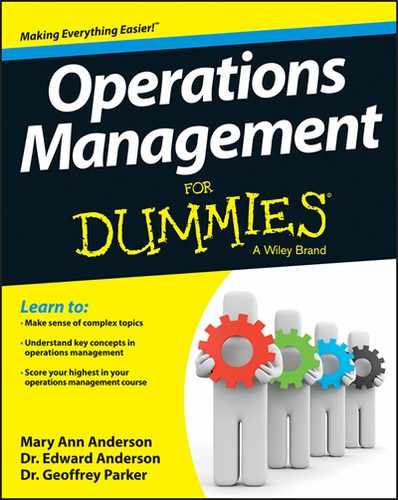Operations Management For Dummies®
Visit www.dummies.com/cheatsheet/operationsmanagement to view this book's cheat sheet.
Table of Contents
Part I: Getting Started with Operations Management
Chapter 1: Discovering the Fundamentals of Operations Management
Defining Operations Management
Seeing the relevance of operations management
Understanding the Process of Operations
Recognizing the diversity of processes
Chapter 2: Defining and Evaluating Processes
Distinguishing between operations and delays
Evaluating the Elements of a System
Getting a handle on constraints
Chapter 3: Designing Processes to Meet Goals
Getting Started with Process Improvement
Placing operations in parallel
Improving Processes According to a Goal
Improving a process that has excess capacity
Getting tripped up by overproduction
Chapter 4: Dealing with Shared Resources, Batches, and Rework
Assigning a resource to more than one operation
Allocating resources to more than one process
Batching Parts and Setting Up Operations
Maximizing operation batch size
Optimizing transfer batch size
Optimizing batch size with operation setups
Putting rework back in the process that created it
Pulling rework out of the main process
Chapter 5: Designing Your Process to Match Your Product or Service
Considering Costs, Standardization, Volume, and Flexibility
Blurring the lines: Making standardized stuff customizable
Improving Face-to-Face and Back-Office Operations
Strengthening the customer interface
Improving efficiencies behind the scenes
Fulfilling Customer Demand: Making to Stock or Making to Order
A tale of two companies: Making either method work
Designing for X: Designing Products with Operations in Mind
Part II: Managing Variability and Risk
Building a Forecast to Predict Demand
Looking to the past to predict the future
Acknowledging the Error of Your Ways
Hunting down the source of your error
Measuring how inaccurate you are
Balancing Capacity and Inventory
Addressing Wait Time for Services
Estimating waiting time with queuing theory
Dealing with the Business of Inventory
Recognizing inventory’s purposes
Measuring the true cost of inventory
Getting Baseline Data on Performance
Assessing the inventory management system
Evaluating the quality of customer service
Reducing Inventory without Sacrificing Customer Service
Multitasking inventory: The commonality approach
Holding on: The postponement strategy
Managing Inventory across the Supply Chain
Keeping track of the pipeline inventory
Setting service levels with multiple suppliers
Chapter 9: Planning for Successful Operations
Determining corporate strategy
Exploring the Components of an Aggregate Plan
Gathering information for the system
Taking MRP data to the factory floor
Seeing the difference in services
Applying Information to the Entire Organization
Chapter 10: Managing the Supply Chain
Seeing the Structure of Supply Chains
Aligning the Supply Chain with Business Strategy
Choosing the right supply chain strategy
Improving Supply Chain Management
Outsourcing inventory management
Simplifying the chain by consolidating shipments
Part III: Improving Operations
Implementing continuous improvement
Differentiating the customer interface
Recognizing the Value of Quality
Getting the perks of high quality
Preventing defects in the first place
Sticking to the improvement effort
Measuring “goodness” of a process
Chapter 13: Creating a Quality Organization
Reaching Beyond Traditional Improvement Programs
Avoiding the lure of magical solutions
Chapter 14: Using Communication and Leadership Skills When Managing Projects
Seeing the interaction of factors
Figuring Out Why Projects Fail
Laying Out the Project Management Life Cycle
Detailing the phases of the cycle
Developing a project proposal with a team
Communicating with stakeholders
Keeping stakeholders in the loop
Chapter 15: Estimating and Scheduling Projects
Chapter 16: Responding to Risks That Threaten Your Project
Monitoring the metrics: Who’s responsible?
Realizing your project’s in trouble
Planning Ahead with Risk Registers
Responding Productively to Risk
Staying productive: Parkinson’s law
Recovering from delays: Brook’s law and Homer’s law
Part V: Scaling and Globalizing Your Operations
Chapter 17: Considering Outsourcing
Seeing the Upsides and Downsides of Outsourcing
Figuring out what to outsource
Developing a lasting relationship
Chapter 18: Scaling Operations throughout the Product Life Cycle
Managing Operations Age-Appropriately
Starting off with high pricing
Designing a supply chain for a new product
Defining a market with no competitors
Avoiding failure in incubation
Surviving the Awkward Stage of Quick Growth
Slowly decreasing your pricing
Distinguishing your product from competitors’ products
Upping production to meet increased demand
Getting Comfortable with Market Maturity
Staying the course with steady demand
Exploiting predictable capacity
Balancing a mature supply chain
Gaining market share over your competitors
Foreseeing the market’s decline
Making the most of lower pricing
Consolidating the supply chain
Increasing sales as competitors exit
Changing the product portfolio
Chapter 19: Ten Pivotal Operations Management Developments
Chapter 20: Ten Mistakes That New Operations Managers Make
Beginning an Improvement Journey without a Map
Creating Overly Complex Processes
Not Doing Enough Project Planning Upfront
Chapter 21: Ten Traits of World-Class Operations
Possessing Profound Knowledge of the Customer
Paying Constant Attention to Product Offerings
Using Relevant Process Metrics
Balancing Respect and Expectations for the Supply Chain
